These are the last two segments from the lecture I gave at the University of Utah School of Art in 2007, titled Visiting Artist [sic]. They’re both about Robert Smithson. The first [above] is about Smithson’s own 1972 slideshow lecture at the UofU, “Hotel Palenque,” which he also published as an Artforum article, and which his estate eventually sold to the Guggenheim as a multimedia installation piece of art.
I love “Hotel Palenque,” and took its irreverent challenge to the orthodoxy of art and art criticism as part of the inspiration for some of my own talk. In preparation for my own lecture, I tracked down some people who were present at Smithson’s original lecture, to see what the artist may have said or indicated at the time.
Unlike the Guggenheim, I am deeply unconvinced that the lecture is a work of art per se. But I find it useful asking how and why treat this thing [sic] an artist made/did/said differently depending on whether it is or isn’t Art.
The second clip is the hometown favorite, the Spiral Jetty. In 2007, the big questions surrounding the Jetty concerned its recognition as a tourist attraction. The state government decided to do a big cleanup of the industrial detritus and abandoned machinery on Rozel Point [they arbitrarily classified wood and stone structures as “historic,” while removing all metal.] And then Smithson’s widow Nancy Holt made offhand comments about how it’d be fine with Bob to rebuild the Jetty, because that wasn’t the kind of entropy he meant, anyway. So I riffed on what kind of entropy might be best for a once-obscure, once-abandoned, now-popular Earthwork.
All Visiting Artist [sic] posts:
Parts 2 & 3: On Dan Flavin
Parts 4 & 5: On Throwing Art Away
video of Part 6: On Joep van Lieshout, which I apparently didn’t post here
Parts 7 & 7 [sic] on Robert Smithson
Author: greg
Strange, I’d Seen This Piece Before
But it turns out Torqued Ellipses in the rain and at night are as awesome as classic Grace Jones.
Every Abandoned House On The West Robinson Street Strip
![]()
On one block of West Robinson Rd West Robinwood Rd in Detroit, all but five of the houses are abandoned. Jim Griffioen took photos of both sides of the street. His massive, stitched together photos are on Sweet Juniper and his flickr stream. I flipped the south side and combined them, a la Ed Ruscha’s Every Building On The Sunset Strip.
The Singularity [sweet-juniper]
Previously: Every Building on The Sunset Strip–and then some
Apologies to anyone still living on Robinson St.
“Design as money laundering bon-bon.”
Dan has been my main source of Postopolis! LA coverage this year. Design theorist Benjamin Bratton wrapped up the event’s discussion with an interesting, twisted bow of a speech. He talked about “Post,” but in the sense of Post-/Pre-, not the original Post/Comment the conference’s blogger organizers originally imagined.
He hopes we’re Post-Bubble, for instance, but isn’t quite certain:
Because design was a symbol of the bubble it is also a symbol of the bubble’s collapse. Think of OMA’s burned out Mandarin Hotel as the anti-Bilbao.
….
But what also seems clear at least to me, is that very many ways of doing things, of designing things, of consuming things, of consuming design are very likely, to sample Paul Krugman, zombie ideas. Design as money laundering bon-bon. The destiny of the post-Bilbao coke high of Dubai, seems be a psychotic desert ruin.
I hope Jurgen Bey is already working on Murray Moss’s pitchfork-proof panic room.
Benjamin H. Bratton (Postopolis! LA) [cityofsound.com]
Visiting Artist [sic], Parts 4 & 5: On Throwing Art Away
I didn’t realize it at the time, but these two clips about Cary Leibowitz and Joep van Lieshout end up being related. Both artists make work that directly questions the value that the “Art” label imbues to an object. And though Cary comes at it from a position of artist neediness and Joep from defiant bravado, both address the issue of whether an “Art” object should be preserved.
Which is interesting, since I think MoMA threw out the van Lieshouts they commissioned when they built their new building.
And yeah, no, I don’t know why the YouTube stills for all my videos are green, either. It’s not like I whipped together a faux Flavin in the auditorium or anything.
All Visiting Artist [sic] posts:
Parts 2 & 3: On Dan Flavin
Parts 4 & 5: On Throwing Art Away
video of Part 6: On Joep van Lieshout, which I apparently didn’t post here
Parts 7 & 7 [sic] on Robert Smithson
Visiting Artist [sic], Parts 2 & 3: Dan Flavin
In April 2007, I spoke at the University of Utah as part of their Visiting Artist lecture series.
I was stoked, partly because Robert Smithson had famously spoken at the UofU, too, in 1969; his lecture and slideshow, “Hotel Palenque,” became an influential part of Smithson’s canon, and it’s a personal favorite of mine. After his death, the recording of the lecture declared a work, a “multimedia installation” which has been exhibited in museums and was acquired by the Guggenheim.
I took this somewhat problematic transformation as an inspiration for both my topic and my work. So I rounded up some other examples of how money and attention have impacted contemporary artworks after they have left the artists’ studios. Then in homage to the hilariously crappy film version of “Hotel Palenque” shot from the audience [it can be viewed in its wobbly entirety on Ubu, which describes it as a “Bootleg film/ documentation / artwork by Alex Hubbard”] I gave my younger brother my video camera, and told him to just let it roll.
The lesson was that money and the market will have its way with your work anyway, so you might as well prepare for it; so at the end, I told the audience that in order to remove any ambiguity in the future, I was officially declaring the lecture to be a work, my first in what Paul Morrissey described as “the medium of the lecture circuit.” So I passed around a stack of signed, numbered certificates of authenticity. 46 people took them.
Anyway, I thought the tape was lost immediately after the lecture, but then this weekend, just after the work’s 2-year anniversary, I found it in a bag. So I’m ripping it and posting the various segments of the talk on YouTube.
First up: Parts 2&3, Dan Flavin [I’ll post Part 1, my intro, but I can’t bring myself to intro it.]
In these two segments, I recapped some of the things I found while writing about Flavin’s work for the NY Times in 2005, including how collectors are fetishizing vintage hardware over the artist’s preferred newness, and how the Estate has adapted to that demand, as well as to the discontinuation of Flavin’s original light bulbs and fixtures.
Future segments will look at The Gates, Cary Liebowitz’s work, MoMA and the work of Joep van Lieshout, and changes to Smithson’s Palenque and Spiral Jetty. Stay tuned.
All Visiting Artist [sic] posts:
Parts 2 & 3: On Dan Flavin
Parts 4 & 5: On Throwing Art Away
video of Part 6: On Joep van Lieshout, which I apparently didn’t post here
Parts 7 & 7 [sic] on Robert Smithson
Previously: notes from my interview with Stephen Flavin, which didn’t get to me in time to make the NYT
notes from my interview with Emily Rauh Pulitzer, an early curator and collector of Flavin’s work, also not completed in time to make the Times
on visiting Flavin’s 2004 retrospective at the NGA
Also: Andy Warhol sent an impostor on a college lecture tour in the West; student reporters from the U of U unmasked him, in three parts, I, II, and III [note: U of U student Michelle Condrat researched the historical unfolding of the Fake Warhol Lecture Scandal]
Climate Control [hah]
Seriously, who had the hubris to come up with that phrase? Unbelievable.
The irony, of course, is that early spring and fall are the times of the year when you, the pre-war apartment dweller, realize how little control over your climate you actually have.
It’s freakin’ cold in here, but not cold enough that the boiler kicks in. The sun warms the place nicely in the day, but now you realize that all these months, you’ve actually been dependent on the radiators, not the sun, for your comfort.
Amar Kanwar’s The Torn First Pages
Last September was the first anniversary of what’s now called the Saffron Rebellion, where Burmese monks took to the streets to protest the military government. As a commemoration of that movement, the Stedelijk Museum showed the first of three parts of Indian artist/documentary filmmaker Amar Kanwar’s work in progress about the Burmese resistance.
The title of the project is The Torn First Pages, 2004, which is a reference to the private, anonymous rebellion of a bookshop owner named Ko Than Htay, who was imprisoned for tearing out the first page of everything he sold, pages which contained mandatory praise for the junta.
Parts of footage for The Torn First Pages come from Burmese democracy activists, who surreptitiously tape and smuggle their work to Kanwar in India.
Kanwar talks about the work with the Stedelijk curator above:
I felt that everybody who writes, be it a poem, be it a novel, be it a fashion magazine, whatever, in one way or the other is indebted or connected to Ko Than Htay, because he’s tearing the first page out from any author. It’s not necessarily a specific book. So in a way, I felt that artists of all kinds, writers of all kinds are connected to this. And in many ways what this is all about is your own relationship with authority and your own defiance. Your own need for defiance. Your own articulation. It’s not necessarily that this articulation is going to become public or recognized. So in some way, in order to understand Burma, if one can understand Ko Than Htay and this act of tearing the first page, you can understand what’s happening in Burma. And if you can understand that, you can understand your own life, regardless of where you are.
…
The Torn First Pages is about presenting evidence of a terrible series of crimes, evidence of amazing resistance. In a way, it’s about saying maybe poetry also has a presence, a validity, in a court of law.
…
Everything you remember, there’s a way to remember. If you remember in a particular way, if you look in a particular way, you’re looking only so that it clarifies you in the present. The purpose of clarifying you in the present is only so that you can take a step forward. In that sense, the act of remembering is really the act of moving forward in time.
Longtime readers of greg.org may remember my swooning at Kanwar’s work when I saw it at documenta 11 in 2002.
Amar Kanwar- The Torn First Pages (Part I), 5.09.08 – 1.10.08 [stedelink.nl]
Demands On Washington
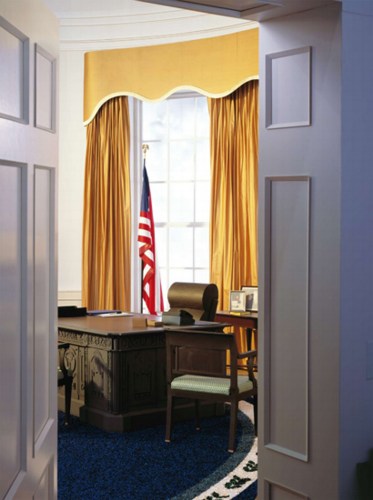
Tyler Green turned his critical shredder on the National Gallery’s new group of Thomas Demand photos depicting his life-sized re-creation of the Oval Office:
The result is a photographed stage set of a stage set used by the United States and its presidents to project and wield power. In a way, Demand has found his ideally reflexive subject. As such, if the NGA wanted to own a Demand, it’s the perfect suite.
But therein lies the disappointment: Demand is a minor academic conceptualist whose use of specially constructed sets to examine memory and to question photographic truth was long ago wrung dry. Ultimately Demand’s Oval Offices look like a kind of illustration — the exact sort of intentionally temporal decoration a magazine would logically commission to illustrate a story.
I’m not as down on Demand’s work as Tyler is, and I think there’s more to the questioning of “photographic truth” that he probably does. Demand’s works have always seemed to me to be about the construction of photographic likeness or verisimilitude, simulation, which is not at all the same as truth. In no small part, they’re about themselves as well, and the deadpan absurdity of their construction.
Sure, the “aha! it’s paper!” moment is fleeting at best, but that’s no different from any number of visually transformative conceptual artists, whether it’s Vic Muniz, James Turrell, Roni Horn, or Charles Ray. It should be a hook, an in to the work, not the end in itself, and I think Thomas clears that hurdle.
And I don’t mind that the photos were commissioned by the NY Times Magazine; and his use of the terms “illustration” and “decoration” are needlessly prescriptive and pejorative, especially coming so soon after Tyler’s own near-mandate that museums have the responsibility to be pursuing politically charged work. [Hold that thought.]
If there’s a problem for me with Demand’s Oval Office photos, it’s the way their “ideal reflexivity” seems so predictably perfect for the National Gallery. Washington is a city obsessed with itself and its own importance, and I can’t imagine how gigantic photos of the epicenter of power could be read here as anything other than adulatory. Actually, it’s not the reading so much as the institutional presentation that’s the problem.
Because context matters, and taken in the context of much of the Demand’s work, I’m not sure if these Oval Office photos are quite the monuments to itself Washington might think they are.
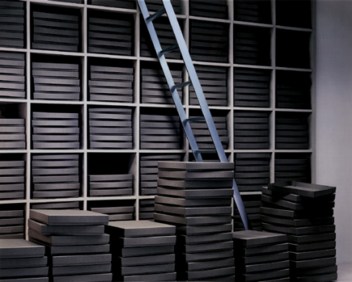
Demand’s critical interest in photographs is inseparable from what MoMA curator Roxana Marcoci called, “his reassessment of the narratives of twentieth century history.”Unlike the instantly recognizable stage set of the Oval Office, many of Demand’s works re-create the generic, banal, unrecognizable sites where uncomfortable History was made: Bill Gates’ Harvard dorm room where he hatched his software plans; the fleabag hotel where L. Ron Hubbard wrote Dianetics; Jeffrey Dahmer’s apartment hallway; Leni Reifenstahl’s personal film archive.
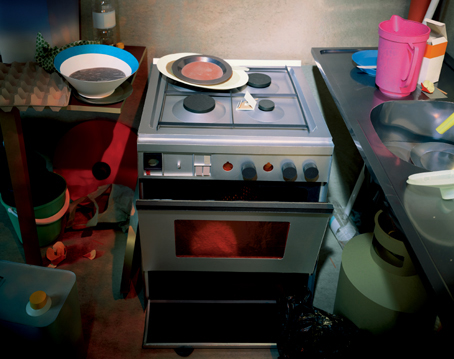
And his reassessment marches right on into the present. Kitchen, 2004 [above], was based on soldiers’ snapshots of the compound where Saddam Hussein was captured. Demand’s last show in New York, in 2007 consisted of re-creations from the artist’s own memory of investigative visits to the cramped offices of Niger’s embassy in Rome. The show was titled “Yellowcake,” and the embassy was the source of the obviously forged documents claiming that Iraq was seeking to build a nuclear bomb, the evidence that George W. Bush called the “smoking gun.”
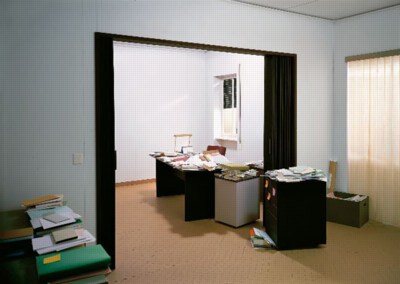
Are we connecting the dots yet? Demand’s Oval Office photos created in the last weeks of the Bush administration are not flat explorations of symbolic power; they’re re-creations of the scene of the crime. And now they’re hanging in the National Gallery. If we look at Demand’s photos and see nothing more than “The Presidential backlot…so familiar — it’s in news photographs nearly every day,” the failure of memory is ours.
Acquisition: Thomas Demand’s ‘Oval Office suite’ at NGA [man]
Thomas Demand, “Oval Office,” November 25 2008 – January 17 2009, Sprueth Magers [spruethmagers.com]
“Yellowcake,” November 3 – December 22 2007 at 303 Gallery [303gallery.com]
Morris, Dunkelman, Humiston
Errol Morris is unfurling another fascinating investigation of a 19th century photograph on hit NY Times blog. Today, in part 2/5, he talks with author and Civil War historian Mark Dunkelman about a breakthrough in researching the life of Amos Humiston, who became famous as the Unknown Soldier who died at Gettysburg:
ERROL MORRIS: As you read the letters for the first time, did you feel that Amos was coming back to life?
MARK DUNKELMAN: Yes. My whole idea of him was changing because I knew nothing of his personality or his personal experiences during the war. He was sick on occasion during the war. He mentions his comrades caring for him like a brother. And he referred to his hands. He said they looked like bird’s claws. That was great stuff. That was the key to me. That was the key. He could speak again. He could be a living person again instead of a corpse in rigor mortis on the battlefield.
Apparently, Bill Levitt’s Sister Was Something Of A Photographer
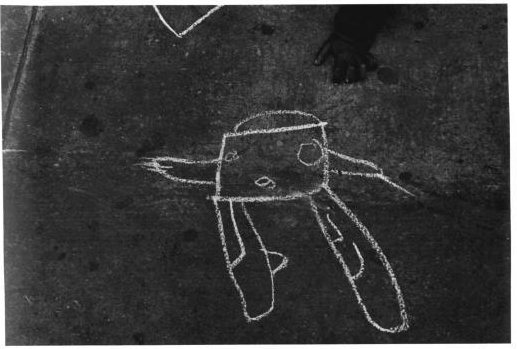
Helen Levitt passed away; she was 95, and an incredible, sensitive photographer of city life. Her pictures of childrens’ chalk drawings are probably my favorites, and I wish the documentary short she made after WWII with James Agee and Frances Loeb, In The Street, was available somewhere online.
But hey-o, why did no one tell me her brother is Bill Levitt, the mayor of Alta, Utah? Levitt and his family own the Alta Lodge and have been instrumental in keeping the resort pristine, safe from overdevelopment, and resolutely and wonderfully old school. Which means Helen left this life knowing that the rope tow was as it should be–about 100 yards too short.
Helen Levitt, 95 [nyt, image via lawrence miller]
The Ambush Photo They Save May Be Your Own
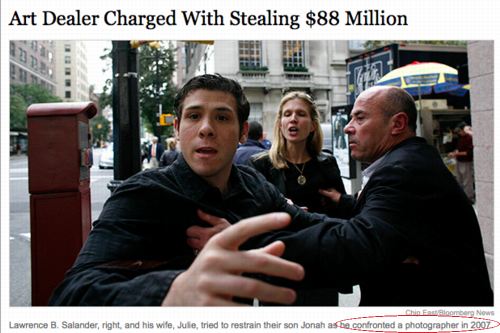
Apparently, with all the digital technology and whatnot, they hold onto that stuff at Bloomberg News, even if you’re not indicted immediately.
Art Dealer Charged With Stealing $88 Million [image: chip east/bloomberg news, photographed in 2007]
I’m Just A Bill

But not that Bill.
The Obamas Get Up Close and Personal In DC [nyt’s automated related link generator]
On The Potential Trainwreck That Is The Artist Talk
What do we really want when we go to an artist’s talk? It’s not like the conventions of the format–darkened auditorium, daisy chain of thank you’s, cuing of slides, thoughtfully forced repartee, polite laughter, tidbit or two of gossip, annoying essay question from the crowd, bumrushing of the stage for a Personal Encounter–should give us any reason to be surprised that the evening turns out to be boring.
I think the theatrical, performative context causes most people go with outsized expectations to be entertained more than enlightened. Tedium is only surpassed by Absurdity on the Artist Talk Enemies List. But what if those were the artist’s unstated goals for the evening? Could it be awesome?
I ask because Knotty Nautilus’s account of a Franz West talk at LACMA sounds positively brilliant. Which is not quite the same as wishing I’d been there myself. There was the game show format; the Austrian sound artist West invited to perform throughout the discussion; some USC MFA’s dressed in homemade West sculpture costumes; and Rirkrit Tiravanija sounding incomprehensible and boring, “a child on ludes performing a book report.”
Now I love Rirkrit like a brother or whatever, and I have a deep, longstanding respect for his work, but after watching the archived stream of his conversation with Bruce Sterling at the Walker Center in 2006–three years ago this week, in fact!–I had to let him know it was the most boring talk I’d ever seen online ever in the history of online. And I began streaming content online in 1995. He was pretty cool about it.
While I’m glad to know a smart absurdist like West takes the artist talk experience seriously enough to screw around with it, Rirkrit reminds me that with some artists, the work is the thing, and looking for Understanding at an artist talk can sometimes be as useless as searching for your keys under the streetlight.
Franz West goes Westside [urbannautilus via man]
Previously: Robert Smithson’s Hotel Palenque: multimedia installation or drunken slide lecture captured on tape?
IRL: Art On Google Maps Smackdown
Paddy Johnson is taking the search for art on Google Maps to a place it’s never been before: In Real Life.
This Saturday, at Capricious Space in Brooklyn, Paddy is hosting a Google Maps artwork faceoff, a real-world, real-time challenge between two artists, James Turrell and Alice Aycock, to see which artist has more works visible to Google’s Eye In The Sky.
Check out details and get a headstart online at ArtFagCity. Meanwhile, I’ll be checking Capricious on Google StreetView regularly; I better not see you loafing around outside with the smokers.
In Real Life: James Turrell and Alice Aycock Face off on Google Maps! [artfagcity.com]
